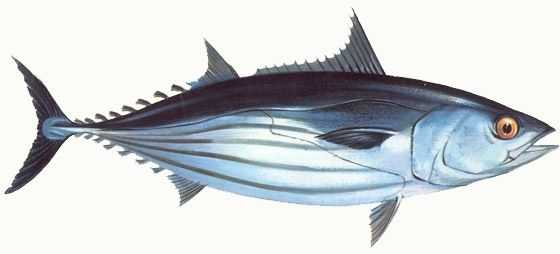Skipjack Tuna

Species Details
Katsuwonus Pelamis
Scombridae
Perciformes
Offshore, Temperate Waters
18 - 76 lbs.
30" - 43"
Skipjack Tuna (Katsuwonus Pelamis)
Skipjack Tuna is a smaller fish in the Scombridae Tuna family. They have a streamlined and torpedo-shaped body adapted for fast swimming. These species live in the pelagic zone of tropical waters all around the world.
They have scales only on the lateral sides of their body and behind the head. They have dark purple or blue color on the back and silver on the lower sides. They also have 4-6 vertical dark bands on their lower body, which looks like dark blotches. Including the abdominal region, half of their body is whitish to pale yellow.
Skipjack Tuna Size
Skipjack Tuna grow quickly, similar to other tropical tunas. Skipjack can reach a maximum of 4 feet in length and 76 pounds in weight; however, the average catch will be around 2-3 feet and 20 pounds. They have a relatively short life span of about 8-12 years.
Skipjack Tuna Fun Facts
Skipjack considered albacore in the canned tuna industry is the most used type of tuna found in canned tuna, especially canned light tuna. Because of their canned tuna market popularity, ICCAT, (The International Commission for the Conservation of Atlantic Tuna)is an inter-governmental fishery organization responsible for the conservation of tunas and tuna-like species in the Atlantic Ocean and its adjacent seas for their protection.
Females can produce between 100,000 and 2 million eggs per year and can spawn as often as once a day. Once fertilized, the eggs hatch in about one day.
They are prey upon by large pelagic fish such as billfish, sharks, and other larger tunas such as the Bluefin Tuna or Yellowfin Tuna. They are also used as bait fish to catch these fish.
These are the most abundant of the tuna species in open oceans of tropical and sub-tropical regions.
You can find them in schools with juvenile Yellowfin Tuna.
They go by many different names such as balaya, tongkol, arctic bonito, mushmouth, oceanic bonito, and striped tuna.
Skipjack Tuna Habitat
Skipjack are tropical tunas that live in the temperate waters of the Atlantic Ocean, Pacific Ocean and Indian Ocean. They are an pelagic fish living offshore in waters below the continental shelf. They are not too fussy about their food, preying on a variety of fish like herring, crustaceans,
Skipjack Tuna Fishing Methods, Baits and Lures
Because Skipjack are a highly valued tuna in the fish canning industry, they mostly caught in a fishery by commercial fishermen with purse seine nets. But when the recreational angler is out to catch one of these, some commonly used methods for them would be pole and line, trolling, handline, and longlining. Because these fish travel so often in big schools, we recommend trolling to be the number one method. The most effective trolling setup is a hoochie rig with a speed range from 4-6 knots. As they usually live in the upper half of the water body, anglers should adjust the depth of the rig accordingly. Other baits you could use are feathers, plugs, or spoons. Skipjack are easily spooked, so be careful to circle the school with the boat and allow your bait to troll as close to the school as possible, even drifting through the school if you can. Trolling is also a useful technique when you are not sure of the location of the fish. If no school is spotted, troll the bait a reasonable distance behind the boat.
If they are feeding on the surface, you could go with jigging, which is useful for reaching larger fish that are deeper in the ocean. Live baits are best, but artificial lures can also be very rewarding. Pink feathers, squids, spoons, skirts and, swimming ballyhoo are artificial baits that should lure them in. For the fly fishermen, epoxy patterns, sand eels and, small deceivers work well for flies.
Skipjack Tuna Distribution
Skipjack Tuna are tropical tunas found in the Atlantic Ocean, Indian Ocean and the Pacific Ocean, with the highest abundance seen near the equator. Suitable water temperature for Skipjack ranges from 15 ֯ F to 30 ֯ F. They swim near the surface at night and when they are feeding during the day. Otherwise, you will probably find them in the depths of 850 feet being a pelagic species. Large schools of adult Skipjack Tuna often mix with juvenile Yellowfin and Bigeye Tuna.






